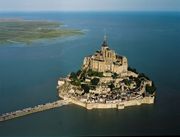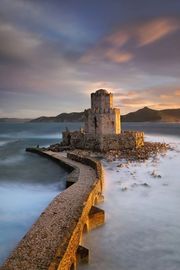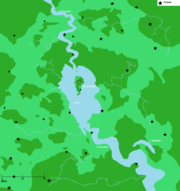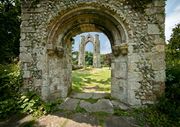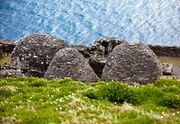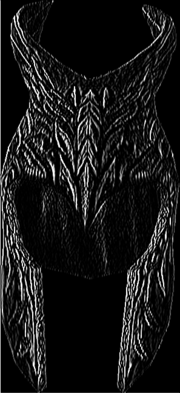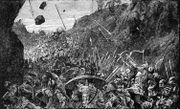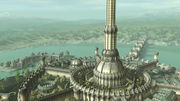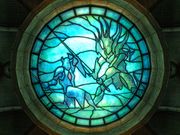History of Avaerilon
The history of Avaerilon is long and varied, beginning millennia in the past with the emergence of the first Fereldic and Sylvan kingdoms, and then culminating in the creation of the kingdom itself in the year 793 AD. Before this time, Avaerilon as a political unit (or indeed even as a name) did not exist, although there was a clear distinction between the modern-day kingdom and neighbouring countries. The first peoples to exist in Avaerilon were the Sylvan elves, a branch of the Western High Elves, and the Fereldics, Celtic humans from the continent who had crossed a pre-historic land bridge to modern-day Fereldan. These two peoples developed their own different cultures, languages and identities, and subsequently created political and eventually national units. They would later be joined by the Dwemer, a mysterious branch of the Eastern High Elves, the Chimer, the ancestors of the Dunmer, another group of Eastern High Elves, the Godels, a group of Celtic humans, and then the Skaal, a Nordic group of humans. In this time the distinct Daelish elves would also emerge, the Fereldonian-bound High Elves, and the Ayleids as well.
Contents
Pre-History and the Mythic Era
The earliest evidence of settlement in Avaerilon dates back to around 1,200,000-1,000,000 B.C., with archaeological finds in central Fereldan and eastern Arnalor suggesting that Fereldic humans and Sylvan elves may have arrived in Avaerilon at around the same time. Early man would have found Fereldan a treacherous and challenging place to live, with large numbers of deadly predators such as wolves, lynxes and dragons posing a sizeable threat, though the thick woods which still survive today were rich in food and materials. These early humans hunted and gathered as per the norm elsewhere, chronicling their achievements on cave walls such as at Fferod Varn in Forlindon, which contains some of the earliest known human artwork. The site was discovered in 1837, when prominent geologist Dr. Iago Heforn Fforwelys noticed the prominent sandstone outcrop in a wooded area, and discovered a small series of caverns, along with the perfectly-preserved drawings. Tests conducted concluded that the artworks were drawn in charcoal, suggesting that the early Fereldics were an inventive and intelligent people.
The early Sylvans were also a hunter-gatherer people in the beginning, but chose to dwell in trees almost exclusively, as has been determined from archaeological remains. Most of these dwellings were at first crude shelters of grasses, leaves and twigs, but soon developed into more complex and strong structures made from a variety of nearby materials. The early elves were literate long before their human neighbours, developing an alphabet and written language sometime around the year 12,000 B.C., sometime after the end of the Ice Age.
The Dwemer are believed to have lived in Morrowind around 880,000 B.C., though little is known of their early existence save for the fact they probably lived underground.
The Mythic Era (ME) is generally agreed to begin with the introduction of literacy into Sylvan society, who began writing in a prototype of the modern Twengar script. Its introduction revolutionised Sylvan society, coinciding with the development of Valarism, the oldest surviving religion native to Avaerilon. The Sylvans began to smelt metal, beginning with softer metals such as copper, but relatively soon after discovering bronze, which they used to fashion weapons, armour and other such items. Sylvan society became more militarised, saw many single social norms develop among different groups of elves, and organised communities began appearing. The Fereldic humans saw their own society develop some time later, when agriculture came to Fereldan. Using crude-fashioned stone and metal-ore tools, the Fereldics began ploughing areas of flat land and planting wild grains and roots, cultivating some of the world's earliest-known crops. This change occurred around the year 10,000 B.C., which is also approximately when the first recorded contact between elf and human is believed to have taken-place. While many historians are unwilling to trust oral accounts of the first meetings, it is generally agreed they were not overly hostile, due to a lack of Sylvan weapons or remains found in Fereldan, and vice-versa. In-addition, several short and fragmented Sindarin inscriptions exist, made by Sylvans at the time. one such tablet reads:
"Upon [entering] the glade, the sound [of] voices... began to be heard. though (?) not unlike [their own], the tongue was distant. [Several] individuals emerged from the trees, [clothed] in leathers. These people [were]... tall and short, fat and thin, of fair and of dark hair. The leader (?) rose his hand in an awed greeting, and [presented] his arm in a sign [of] good faith."
As a result of contact between the two peoples, the Fereldics acquired literacy, and began writing with the Twengar script like their neighbours, though they wrote in Ancient Fereldonian. Due to the literacy shared by the two peoples, we begin to get a clearer picture of the state of affairs in Avaerilon at this time. Both the Sylvans and Fereldonians lived in small communities, though formally-organised, often ruled by a council of elders, nobles, or mages. It would be these small communities which would lay the basis for the creation of the first kingdoms of men and elves. In the year 9000, Lorien was founded by Galadriel her husband Celeborn in the south-east of the isle of Ithildol, with its capital at Lothlorien. It had an organised military and the beginnings of a small navy, as well as an excellent defensive position being in dense woodland. Though it grew slowly, Lorien remained a prosperous kingdom, despite not having any currency.
Since around 12,000 BC, various elven peoples had travelled north to Vanlonil, and then often further on to Fereldan itself, settling in-particular in modern-day Avalon and Denelon in the centre and east of the isle. These elves begun worshipping different gods to their southern king, and created their own pantheon of gods based on gods and goddesses of the various aspects of nature. These elves, now calling themselves the Daelish, lived as nomads, setting-up large camps in glades and clearings in woods and forests, where they lived for some months before moving on to new areas, often eventually forming a circuit.
Eventually, the Daelish banded-together to form the kingdom of Arlathan, which pre-dates even the great kingdom of Avalon in central Fereldan, and was a wealthy and enlightened realm. Though somewhat isolationist, Arlathan was famous for its literature and legends, and the excellence of its spellcasters, as well as the fine weapons and jewellery that came from its craftsmen.
The first human kingdom was Nyrmenor, founded on the islands of the same name in northern Arnalor, in 8131 B.C.. Fereldonians had migrated in large numbers south-west via the sea currents to the isles, which enjoyed large amounts of sunshine, a pleasant maritime climate and fertile soil, for a number of years before the kingdom was founded, and already several settlements were present. Nyrmenor differed from Lorien in having a more centralised monarchy based in the capital of Arminaleth (now Minas Arminaleth) and a more formalised set of laws; in-short more recognisable features of a modern-day country. Around this time, small groups of Sylvans began crossing the sea, first to Vanlonil, and then later to Fereldan itself. Many of these elves settled in modern-day Denelon, and are the earliest ancestors of the Daelish elves.
Not long afterwards, in 8102, the kingdom of Eriador, another Sylvan realm, was founded to the north of Lorien in north-west Ithildol. Its first capital, Mithlond, being on the coast gave the new kingdom a great advantage, with the areas natural harbour making for a safe place for ships to be built and dock, and the kingdom grew prosperous from a steady supply of fish and being an early centre for trade.
Classical Era
The various realms that composed Fereldan and Arnalor underwent a number of important changes in the Classical Era (CE), which begun around 8000 B.C.. Petty kingdoms formed where various tribes and communities banded-together, often with a ruling aristocracy, warlord or council of magi. Some emulated the large, increasingly powerful kingdoms of Eriador, Lorien and Nyrmenor, though many others were different in nearly every way. However, it was clear a number of uniform changes were occurring in the three true kingdoms; their various armies became more organised and professional, maps were made and borders declared, and the system of government in each state became more defined and formalised. Though all three retained their different style of rule, all of them were increasingly modern and organised. These changes inspired elves in central Arnalor to found their own kingdom, and in 7147, the kingdom of Gondolin was founded along the southern coast of central Arnalor. Gondolin was responsible for some great Classical innovations, such as the invention of longer-distance sailing vessels (the trireme), and some of the basic principles of modern construction and engineering. Their capital of the same name was the first purpose-built citadel in Avaerilon, and would inspire the construction of such settlements into the 18th Century AD.
For the first part of the Classical Era, Nyrmenor was the most powerful kingdom, commanding large armies and a powerful, organised navy, and owned considerable wealth. It was the first place in Avaerilon coins were minted and a formal currency implemented. The kingdom was originally ruled by a monarch, who was advised by the heads of the powerful noble families of the realm, the elites of the magi and also by the officiants of the Valar, for the kingdom was mostly Valaristic in its religious beliefs. The kingdom held extensive territories outside of the islands themselves, with lands held in other parts of Arnalor, and also a large colony on the island of Vanlonil. However, as time went on, some monarchs gained more power for themselves, and began exerting their control via a powerful oligarchy of their favoured nobles. Some nobles warned against this situation but were often silenced, either through intimidation or by their concerns falling upon deaf ears. By the 5200s, many of these nobles and their followers, tired of the corruption rampant in their kingdom, set-sail for western Ithildon and Vanlonil.
The Cleansing of Nyrmenor occurred in 5131 BC, during the reign of the last of the old kings, Ar-Phalazon. Intent on establishing an absolute monarchy, Ar-Phalazon had swept-away the last remnants of old society, including most of the magi and all of the Valar officiants from his court. He was opposed by Elendil, who warned of impending doom, but such was his power he did not listen to his enemy. From the writings of those both inside and outside Ar-Phalazon's court, it appears the king became insane due to his obsessional megalomania. Paranoid and unpredictable, he declared his elven neighbours to be traitors for refusing to share the secrets, as he called it, of their long-livedness. Preparing to make war upon them, he mustered a great force of nearly all his ships and soldiers, and intended to attack them by surprise. The war would undoubtedly have killed thousands, and left the lands in a state of ruin. Foreseeing the terrible consequences, Elendil gathered his family, his followers, and a large number of refugees, and set sail for modern-day Gondor. Refusing to leave was the master-wizard Jubasto, who summoned what is perhaps the most powerful spell in history, and cast a tsunami upon the assembled forces of Ar-Phalazon. The raw arcane energy killed him outright, but the spell was successful, and the entire force was destroyed. A great number of people were killed, refusing to heed the warnings of Jubasto, mostly living in villages close to the affected area in the west of the country. However, most of the population (who lived further inland) remained unharmed, and were thus able to re-establish a functioning country.
However, the country had lost its capital, much of its wealth, and all its armies. Nobles from its colony in Vanlonil had to be dispatched to Nyrmenor itself, as none save Elendil and his followers survived. They managed to slowly restore the nation to a portion of its strength, but failed to achieve anywhere near the wealth and splendour of the old kingdom. It retained Vanlonil, and achieved rebuilding a powerful navy, but was a lesser power from then on. Elendil himself was invited back to the kingdom, being offered the crown as was his right as the most senior old noble remaining; he refused, though by rights his lineage was entitled to claim the throne of the kingdom. No successive ruler ever revoked this entitlement, and it remained when Arthur claimed the throne thousands of years later.
A little after this time, the kingdom of Gondor was founded in 5129 BC, with its first city located at Osgiliath. Elendil ruled as its king, and their language was for a time Nyrmenorian (a dialect of Fereldonian), written in the Twengar script of the Sylvans. Gondor prospered, with its holdings eventually spreading as far south as the Aeglinic isles. Around this time too, the Aeglinic alphabet was born; the first Fereldic alphabet. It would eventually give rise to the Aelginic language, still spoken in southern Deracilon.
In 5129 BC, the kingdom of Gondolin was founded in south-east Eredorn, by Sylvan lords from elsewhere, and over the years grew to become the successor of Nyrmenor's wealth and territory. By 3970 BC, it was the most powerful kingdom ever seen, with a modern, powerful navy, the trading-capital of all the land, and the most-admired army that had ever existed. It was perhaps this wealth and majesty which drew its eventual destruction, as in 3094 BC, orcs from the continent invaded and began their siege of the citadel of Gondolin itself. Some of the most legendary weapons, such as Orcrist and Glamdring, were forged in that period for the terrible wars, and the elves were confident of their success. However, they refused the help of their neighbours, and a surprise landing by orcish spellcasters, with demons in-tow, caught the defenders off-guard. The citadel walls were breached, and the invaders managed to take the citadel successfully, though not before a stream of refugees were able to escape.
It was then that the chief lord of the citadel, Cevelon the Great, opened the floodgates of the city (which had been built in a former cove drained of its water), which drowned the entire citadel and buried it underwater, killing the invaders. Some of the outer buildings escaped the water, and can be seen today, and the impressive seal walls are equally pristine, though the citadel itself is still underwater. The kingdom, like Nyrmenor, was crippled by the loss of its capital, though it remained and important realm for many more years, thanks to the port town of Lothdeingdel and the strength of its surviving armies.
In the year 4585 BC, the Chimer people, led by Veloth, arrived in Morrowind, which they named Resdayn. They brought with them Daedra worship and the Chimeri language, and first settled in the north of Vvardenfell, around the present-day village of Ald Velothis. These people would be the ancestors of the Dunmer, and began colonising wide areas of Vvardenfel and Velotheran. The early Chimer were literate, and recorded much of their history which survives today. Their meeting with the Dwemer appears to have been ambivalent, with the Dwemer content to allow these newcomers to live on the surface, though they were less than favourable to their religion. Nevertheless, relations between the two appear to have been relatively cordial. The Chimeric society at this time was nomadic, with camps of Chimer romang the wide countryside of Morrowind, staying in one place for a few months and then moving on. They cultivated little at this time, foraging for vegetables and the suchlike instead, though they did begin domesticating creatures such as the Shalk and Guar and this early time. Clans of Dunmer were ruled by an Ashkahn, a sort of warrior-leader, with his trusted lieutenants as Gulahkahns, and the most learned woman of magic as his chief advisor.
4801 BC saw the first formal religion outside of Valarism develop; the Aedric faith. The earliest references to the Eight are found in modern-day northern Cyrodiil, with inscriptions in Aeglinic describing various aspects of the gods. It is believed groups of worshippers began meeting in the same places, and thus the earliest shrines and chapels came-into being. These would have been simple structures, made of stones and wood harvested from surrounding areas but later grew-into more complex structures. Aedracism began to spread south of Cyrodiil, though slowly, and also north and west.
The first Gaelic peoples, speaking the ancestor tongue of modern-day Godeleic, arrived in Dunaemair around the year 4078 BC. It is speculated that they had arrived earlier, though no archaeological evidence of this exists. Our earliest account of them is from Fereldonian scholars sailing from Nyrmenor to northern Fereldan, mentioning:
"Oddly-speaking peoples from the north, dressed for rough weather indeed, calling themselves, we believe, 'Gaels.' Our languages are obviously not totally alien, but they know nothing of our lands to the south, and were most amazed to gaze upon the elves with their long ears. Some of them look like pirates, and this may well be trouble. Others seemed more interested in doing business, and had no trouble trading with some of the men. They were eager for wheat and the suchlike, for it appears the weather is foul where they live, and gave in return furs and leathers of excellent providence."
One of the earliest kingdoms of men, Braconil, was founded in the year 3272 by Brachon I, who hailed from southern Fereldan and desired his own kingdom. Braconil grew into a modestly wealthy country, and prospered in modern-day Pernlem. A number of large, early castles were built, exhibiting advanced construction techniques such as modern mortaring and buttresses. However, strife came to the kingdom around the year 3080 BC, when the new king Qerthelos curtailed the status of mages in society. He was part of a growing number of nobles unhappy with the power of those with magical abilities, and the prominence of the Council of Magi within the court of the king. Accusing them of meddling in affairs that did not concern them, Qerthelos planned to expel all spellcasters from his kingdom. This eventually led to a large opposition to the king arising, led by the charismatic noble and wizard Aubrey Lersamdrag. He represented a small but powerful group of nobles favourable towards magic, with some of them having arcane powers themselves. He urged tolerance and understanding, and asked his king to reconsider his position on magic. Although we do not know if he was forced-into exile or chose it himself, Lersamdrag was ultimately unsuccessful in that venture, and so in 3065, he left with a great retinue of his family and household, his warriors, allies and many of the kingdom's mages, heading north-east. This train of exiles faced many hardships at first, but due to good weather and luck they were able to arrive at Lake Sarn, with the Isle of Avalon in its midst, in modern-day Avalon. Lersamdrag decided to found his own kingdom, and named it Avalon, meaning 'isle of the verdant glades.'
The Dwemer
The Dwemer people, the oldest inhabitants of Morrowind, are believed to have arrived in Morrowind sometime after the lands of Arnalor and Fereldan were populated, though little is known of their activities at this time. Our only evidence of this existence is from archaeological finds and brief references to their ancient past in their own literature, and little can be gathered from this other than that they chose to dwell below ground, and lived most abundantly in Vvardenfell. However, our information increases greatly during the Classical Era, primarily due to Fereldonian sources. The Gondorian explorer and philosopher Marthendil mapped parts of Morrowind from the years 4052-4044 BC, and came across the Dwemer during his travels. From him we gain some of our earliest evidence of them.
"It was not long after leaving the marshlands of the south [Vvardenfell] that I came-upon a most peculiar site, which was six great towers of metal and what appeared to be stone, upright like the fingers of ringed giants, and then, in their midst, was a number of low buildings and a sort of sphere of stone. I advanced in wonder, and then a great surprise came-upon me as the sphere revolved, revealing a door, and out of this door came a group of three individuals. They were shorter than I, though not by much, and were clad in the most exquisite robes, with metal armour the like of which I have never seen upon them. Bearded luxuriantly, they spoke to me in a tongue I did not know. As I could not understand them, I hailed them in Chimeri, for I have learned that tongue so as to traverse Resdayn, and asked if they spoke it. One replied that he did, and made himself known as Azmurador, a Deep-Elf, or Dwemer."
It was during the classical era that the Dwemer first forged their famous amber-coloured metal, heavier and stronger than iron, and their deep-mining began, as did their early attempts at machinery. At this point in time, they had not achieved the levels of sophistication which have made their kind famous, though they did have crude forms of pumps and pulleys to drain water. Approximately 17 separate Dwemer sites from this period have been found; though smaller and less complex than their later settlements, they were made of the same concrete-like stone invented by the Dwemer, and their art style obviously derives from this period.
The Dwemer appear to have lived alone from the other races, shunning their company and seldom receiving visitors, though they were happy to give men like Marthendil accounts of their history and heritage.
The Skaal and Solsteim
Around the year 5000 BC, the frozen island of Solsteim, located north-west of Vvardenfel, was first discovered and inhabited by a group of Nordic people, calling themselves the Skaal. In-addition to their Nordic language, Skaal, they also brought their own culture akin to Nords elsewhere. The modern-day town of Skaalhold is reckoned to be the first major permanent settlement by the Skaal after some years of nomadic living, located in the north of the isle, with Skaal travelling elsewhere later on, including to Thirsk, where they erected feasting hall and later a town.
Aside from obvious conclusions drawn from archaeology and what is contained in surviving literature, relatively little is known of the history of the Skaal prior to the arrival of the Cyrodiilic Empire in the Ancient Era. However, given the number of standing stones and burial mounds, it can be determined the Skaal worshipped in much the same way as many continue to today, believing in a number of deities associated with the aspects of nature. Customs included celebrating phases of the moon and burying the dead in communal mounds, with the celebrated dead being encased in the rare material Stalhrim. The Skaal were not able to farm extensively in the harsh Solsteim climate, although rye was grown successfully as a cereal crop and fish was plentiful, but nonetheless were a successful people surviving in such a climate alongside the various dangerous beasts which continue to stalk the land. The early Skaal were also skilled navigators and shipwrights, and made important advances in terms of contemporary shipbuilding, employing techniques used into the 1800s.
Contact between the Skaal and their neighbours was not made until the War of the First Council, at which time they were employed as mercenaries by the Great Houses of Morrowind, having already landed on Vvardenfel and establishing small camps along the coast. These smaller settlements were later abandoned, probably on the orders of the Tribunal after the war, keen to remove as many foreign peoples from Morrowind as possible. Contact between the Skaal and western Avaerilon came not long after, with Skaal ships arriving on the northern Fereldonian coasts and trade quickly being established. It was from Fereldan that barley, mead and modern smithing came to Solsteim, which in turn introduced rye and new shipbuilding techniques to Fereldan.
Ancient Era
Avalon, Gondor and Anoren
The fledgling kingdom of Avalon in central Fereldan began expanding in the Ancient Era, a process started by Hwgō the Bold in 2999 BC. Having recently risen to the throne after the death of his father, Persival Lersamdrag, Hwgō had ambitions to increase the size of his fairly modest kingdom considerably. Having begun as essentially an isle in the midst of a lake (Llīn Sarn) with surrounding farmland, Avalon would hugely increase in size under Hwgō's reign. Sending teams of men far and wide, the young king had simple towers constructed at various strategic points, essentially forming a border. Once a complete set of outer towers was established, some of these wooden structures were converted into more complex stone towers, while others became fortresses, some utilising hills and high ground to become hill forts. Hwgō also built towers and forts within his new borders to ensure security from bandits and any other undesirables, which encouraged his denizens to settle other parts of the kingdom aside from Caer Sarn.
By the end of Hwgō's reign in 2957 BC, Avalon had expanded to include much of the modern-day shires of Caradon, Amdragilorn, Branlorn and Gwesterlorn, making it the largest kingdom in Fereldan. Growth would continue under Hwgō's son, Garadin the Wise, who turned his attention northwards. On the back of his father's successful program of fortress-building, Garadin sent men into modern-day Fferwen to build fortresses for the purpose of expanding and guarding his northern borders. Relations with the wilder folk of Fferwen were not always warm, and in 2873 an invasion threatened the existence of Avalon's northern territory, when the barbarian folk began raiding a number of more isolated villages, and were in sufficient numbers to threaten Avalonian fortresses. Avalon defeated them, however, under the brilliant leadership of the seasoned fortress commander, Bran the Stern, who allied with a number of sympathetic wilder clans and organised the northern Avalonian soldiery in an expert plan. Bran's victory led to King Alstern granting the commander the title of Marqes, which itself led to the creation of the formal system of regions and marquises which exists today in Avaerilon. Bran's name also gave birth to the region of Branlorn, which he governed on behalf of the king until his death in 2808 BC.
Fortune had not been so kind to the Kingdom of Gondor by this time, however. Gondor had once controlled a wide swathe of territory, mostly stretching along the eastern coast of Fereldan from modern-day Denelon to the Aeglinic Isles, and had for a time been considered the most powerful kingdom of men. However, a series of costly wars against rival powers, barbarians, invaders and powerful dark wizards had taken their toll on the kingdom, and by 2685 BC, Gondor held around a quarter of what it once controlled. Its rulers had believed their naval superiority and citadels, which had made Nyrmenor so great, would do the same for Gondor; while initially this was the case, the kingdom overstretched itself, and became over-reliant on ships and fleets of war boats to defend it, rather than ensuring it had a land army to protect its wast swathes of land. Its southern colonies in Aeglinica were cut-off as a result of the war with Umbar, its holdings in modern-day Vencestia and other parts of Deracilon saw rebellion, exodus and invasion, and its northern territories were seized by dark wizards and barbarian mercenaries. Eventually, the kingdom could not afford to look after anything but its core areas adjacent to the central part of the kingdom itself, and parts of the kingdom which remained loyal were left to fend for themselves.
Gondor increasingly relied on its western neighbour, Avalon, for assistance in defending itself, and the mood of many Gondorians was that a union with Avalon was preferable to their current situation. This was seen as practical by the rulers of both Gondor and Avalon, particularly since Prince Lēowellyn of Avalon and Princess Elwen of Gondor were courting. Their fathers decided to abdicate in favour of their respective heirs, and the two married, created a united kingdom of Avalon and Gondor known as Anoren.
Anoren prospered over the course of its existence, with the great port-city of Osgiliath being unrivalled in size or wealth, and a great number of citadels built across the kingdom. Its borders expanded and Anoren was regarded as easily the most wealthy and powerful kingdom in the land. The arts flourished, as did literacy and arcane studies, and its existence is generally reckoned to be a golden age of enlightenment and prosperity. Even today, second only to the later realm of Arnor.
By 2250 BC, however, the kingdom was fighting for its life, with the terrible armies of Angmar in the north descending upon Avalon, and the Orcs of the east invading Gondor. The kingdom began to lose territory and battles, and it was feared that the realm might even be defeated in the face of such opposition. However, thanks to the sheer iron will of the armies of battlemages, and the courage and tactical brilliance of the young king Arathorn, the tide was turned when the vile Witch King of Angmar was defeated in a surprise attack, and then again at his fortress in his own kingdom by Arnorenian troops, led by their king. Armed with the ancient sword of Īsildyr, Arathorn cast-down the vile wraith and warlock and took his territory for Avalon. The Orcs were disheartened at the loss of their principal ally, and began a retreat from Gondor. The did not leave before striking a crippling blow to the kingdom, however.
For some time, since the war had begun, the nobles of Avalon and Gondor had been bickering, with the two parts of the kingdom being at-odds with each other. The Avalonians accused the Gondorians of leaving them to fight the major battles, while the Gondorians insisted their smaller region was contributing the majority of the produce which kept the kingdom going. Furthermore, Avalonian nobles supported the continued high position of mages in the kingdom, while the Gondorians favoured abolishing magisters from the senior positions and instead having stewards fulfil the roles. The contemporary scholar Dolan Derastil wrote of the strife, describing a kingdom on the verge of breaking-up.
"Caer Sarn and Caer Lorn felt they were the workhorses in the struggle, whilst Osgiliath and Minas Tirith believed it was they who were giving the most in the war. And the passions of the mages- those in the west of Caer Sarn, and those in the east of Minas Ithil- were also aflame, with the rival wizards grasping for power in the unstable atmosphere. Hostility towards one's neighbour was nearly as common as to one's enemy, be it the northmen of Angmar or the dreaded Orcs of the east. Farmers in Ithilien readily believed their western counterparts were failing to pill their weight, whilst officers in Fferwen swore only their troops were fighting the major battles. It was an atmosphere as poisonous as a warlock's gloam."
The fragile kingdom was arguable held together only by the charisma of Arathorn, who acted as a figurehead and a leader the men of Avalon and Gondor could both identify with, and many saw him as a sort of spiritual and moral figurehead. The nobles were content to follow his lead due to the respect they had for him, and believed as long as Arathorn, who had the blood both of Avalonian and Gondorian royalty in his veins, was their leader, they would remain a single kingdom. The inevitable happened when Arathorn was killed in 2225 BC, while routing one of the last parties of Orcs in Gondor. Struck from behind with an arrow, he died on the battlefield, and many believed he died without an heir. With tempers strained and passions fierce, the nobles of Anoren declared that though their people had survived, the kingdom had died with their king, and so it was decided that the two realms of Avalon and Gondor would part ways. Avalon continued to be a monarchy, with the mages appointing a noble to lead as king until his death, while Gondor, though it retained the title of 'Kingdom,' effectively became a republic, with a Steward chosen to lead.
Ancient Dunaemair
Ancient Dunaemairan society bears a considerable resemblance to iron-age Irish society; the people of Dunaemair were loosely grouped-together under one high king or queen, who served as a spiritual figure and mediator, with the actual state of affairs being one of several different rival kingdoms, led by the more powerful clans or noble families. For centuries, power shifted between the north and centre of Dunaemair, primarily between Édintír and Rudeantír and their respective capitals.
Resdayn
Arnor
The Ayleids
The elven peoples of western Arnalor were numerous and diverse, but most notable of them were the Ayleids, a people whose society and culture lasted for around a millennium before war and strife destroyed it. During that time, they would emerge as a key power in Avaerilon, although ever a controversial one.
By 2550 BC, a dominant group of elves had emerged in the modern-day regions of Eredlwnil, Cernhastil and Rhōvanīon in western Arnalor; the Ayleids. Dedicated sorcerers, the Ayleids rejected the teachings of the Valar and instead favoured Daedracism. Scholars believe the Ayleids had their origins in the nobility of several clans in southern Eredlwnil, and their power and influence spread from there. Most historians reject the nation that they were a singular ethnic group, distinct from other Sylvans; instead, the Ayleids had a unique language and culture.
2549 BC is the first date that can accurately be attributed to the formation of any formal Ayleid state, whose name was Ayeleronesteri in their own tongue, which roughly means "the heartlands of the high Ayelid elves." The other elves called them Gwâthdelir, or 'shadow elves,' in reference to their perceived approval of dark magic and their imperial designs, and their state was known as (in) Aranarth Dû, or "(the) Realm of Dusk." Fereldic speakers used the term "Ayleid," usually spelt Ēlȳid, though a number of other names, including some derogatory, were not uncommon. Their realm was known as Cedrelēlon.
The Ayleids generally shared the hostility their neighbours had for them, and viewed humans as inferior beings; this ultimately led to the adoption of slavery, which was generally reviled across Arnalor and Fereldan, and also provided wealth for the powerful Ayleid nobles. War begun formally in 2496 BC, though sporadic skirmishes had been occurring long before then, when the Imperial Magister Giroth Gel-Varatis sent his armies east in an attempt to begin a conquest of Arnalor. His armies were successful in taking large areas of Eredlwnil, Cernhastil and Rhōvanīon, as well as establishing a prominent colony in northern Galadlonil, but strong opposition from Gondolin, supported by soldiers from both Eriador and Lorien, prevented him from making inroads further east. Eregion was untouched by any notable Ayelid presence for the duration of the war, which went on for centuries in a series of stalemates, the Ayelids advancing east only to be pushed-back by Sylvan forces, and then for the Sylvans to push forward but encounter the sheer arcane strength of the noble magisters the Ayleids relied-on so heavily.
In the end, it was the union of Avalon and Eriador to create Arnor that routed the Ayelids from their ancient heartlands and won this war for the allies. Having been created in 2136 BC, Arnor had access to the seasoned and skilled armies of Avalon, along with their spellcasters who could match the Ayleids. Intelligent usage of naval forces routed the Ayleids from Galadlonil, and support from the people of Cernhastil drove the Ayleids back. After the death of Aragorn in 2024 BC, the Arnorians lost some of their vigour, but that was renewed when Nyrmenor, for so long neutral in the conflict, finally joined the allies and utilised its great fleet to assist Arnorian efforts to blockade the Ayleids. From then on, the Ayleids were fighting a lost cause, and in 1973 BC they were finally cast-down, with the Imperial Magister Gel-Varatis killed in a mind-duel with the famed battlemage and Prince of Arnor, Awrelys the Great.
Ayelid society in Arnalor disintegrated with the fleeing of the ruling aristocracy, with only the isolated colony in northern Galadlonil remaining somewhat intact. The Ayleid nobles fled for Vanlonil, along with their loyal subjects, though many were killed in naval battles trying to flee northwards. Settling on the southern side of the island, the Ayleids remained there until 1819 BC, when a coalition of Arnorien and Nyrmeoniran forces drove them out.
Again the aristocrats fled, this time making for Fereldan, where in the wilderness and vast woodlands they were able to establish themselves more successfully. Some invaded Lancyr in the west, and occupied it as the ruling aristocracy until a rebellion saw their power toppled, while some others headed for modern-day Denelon, where they eventually mixed with other elves already present and became the nomadic Daelish elves. However, the majority aimed for Cyrodiil, the bowl-shaped area south of Avalon, where only small, petty kingdoms of men were, after failing in Deracilon.
The Ayleids, with their well-equipped and disciplined soldiers, and their mastery of the arcane, were easily able to overpower the human opposition. Entering from the south in Nibenay, the Ayelids made the Isle of Emperors (Ilnys Elmedyrīnol) in Lake Rumare (Llīn Rwmaril) their headquarters, and begun the building of White Gold Tower and the centre of the modern-day city of Septilonath. From this central vantage-point, the Ayleids were effective in their conquest of the region, and within 25 years the entirety of modern-day Cyrodiil was under Ayleid rule. Great underground cities were built from whitestone, monuments and statues erected, and other great works were begun, much of the labour deriving from human slaves, with some elves also enslaved, usually for worship of the Valar or non-Ayleid lineage.
Cyrodiilic Ayleid society developed into it being a realm of numerous kings, with one high priest-king, usually the most powerful magister from the most powerful family chosen to rule. This fiercely aristocratic and oligarchic society became rich and powerful, and many among them felt the Ayleids had reached the height of their prowess and splendour. Of course, opposition to the Ayelids came in the form of their northern neighbours, Arnor, who made war against them in 1741 BC, attempting to overthrow them. While Arnor did indeed prevent the Ayelids from expanding any further, and also defeated the Ayelid rulers in Lancyr further west, they could not uproot the Ayelids from Cyrodiil, with their underground fortresses, armies of Daedra and complex magic offering a genuine challenge to the might of the Arnorien men and elves. Eventually, Arnor's rulers realised they could not win easily in a conventional war, and so set-about manipulating their enemy from within; sympathisers were identified and assisted in gaining political power, with the aim of being in a position of authority enough to overthrow Ayleid powers in specific areas, and contacts were made among the slave community, with secret loads of weapons and resources delivered under the cover of darkness from Arnor.
In 1449 BC, the powerful sorcerer Umaril, whose fief was Garlas Malatar in western Colovia, was made high king of the Ayleids, and also commander of their armies; a first in the history of the Cyrodiilic Ayleids. Umaril hoped to invade Denelon by sea and thus place Arnor under additional pressure, and planned an eventual invasion of the kingdom's north-eastern flank. It was then that the fruits of Arnor's long, quiet labour began to truly pay off, and several powerful aristocrats, secretly Arnorian agents or sympathisers, were in positions of power around Cyrodiil. There was also a greater sense of community among the human (and elven) slaves, which would come to a head in 1443.
1443 saw the beginning of the Alessian Rebellion, with the young woman Alessia inspiring and rallying the salves into a formal rebel force, bolstered with Arnorian arms. It caught Umaril and his fellow kings off-guard, and thus the rebels were quickly able to gain control of key areas such as southern Colovia and the Merals. Arnorian battlemages entered the country and assited in the fighting, while pro-Arnorian nobles began attacking their neighbours and rebelling against their king. The Ayleids countered in a bloody series of skirmishes, which left thousands dead, but with the armies of Alessia under the command of the brilliant Pelinal Gwenfrod, the Ayleids were hard-pressed.
As the years progressed, Alyeid-held territory diminished to their underground cities, parts of southern Nibenay and the Isle of Emperors. In 1439, Umaril realised the holy aura of Pelinal was a great inspiring force for the rebels, and set a trap for him, allowing the rebel forces to easily take White Gold Tower, where he waited for his enemy. He and Pelinal were engaged in single-combat, and Pelinal bested Umaril, though his soul survived and would later wreak havoc upon Cyrodiil (see below). Pelinal, however, was then set-upon by the Ayelid army, which had hidden from the small rebel force outside the city, and he was executed by the Ayelid kings. Alessia is said to have arrived the next day, and found the severed head of Pelinal in the highest room of the tower, discovered by a second wave of (successful) rebels.
Umaril had been incorrect in thinking Pelinal's death would have staunched the rebel initiate; under Alessia, who whipped them up into a fury, the rebels were not disheartened and attacked with great vigour, finally casting-down the Ayleids from their cities. Alessia was crowned Empress of Cyrodiil, though she died nine days later after committing a sacred immolation, whence she is believed to have ascended to heaven. The Alyedis, though still their cities remained and their temples stood, had been defeated and driven from power, and their defeat in Cyrodiil marked the end of true Ayleid civilisation cross Avaerilon.




